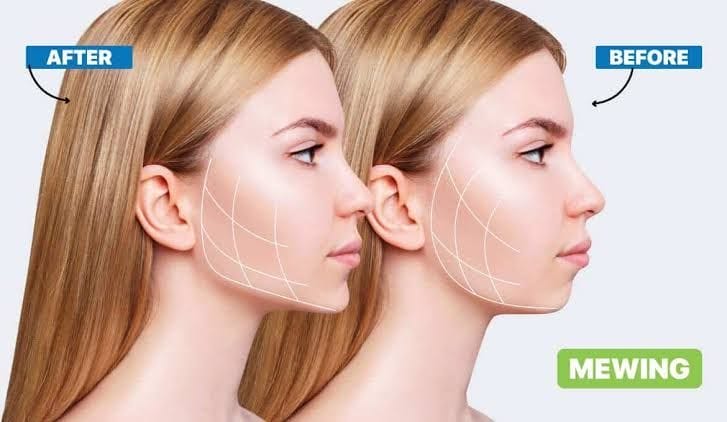Mewing is a technique that involves positioning the tongue in a specific way in the mouth to improve facial structure and alleviate various health issues. It has gained popularity recently, especially in online communities focused on beauty, health, and wellness.
It is, therefore, imperative to get an educational overview of mewing and its potential benefits and address common criticisms and controversies surrounding the practice.
* Due to recent online trends related to health and wellness, we always that you speak with your local dentist or physician before following advice found through popular social media platforms!
This article was written and reviewed by dentists at 3V Dental Associates. 3V Dental Associates is a General and Cosmetic Dental Practice with Offices in Port Washington and Massapequa.
Anecdotal Image of Mewing Face Before and After

What Is Mewing and How Does It Actually Work?
If you’ve spent any time scrolling through health or beauty content online, chances are you’ve come across something called “mewing.” Maybe you’re wondering if it’s legit, if it actually works, or whether you or your child should be doing it. You’re not alone. At 3V Dental, we get questions about mewing more and more, especially from parents concerned about jaw development, facial structure, or mouth breathing.
Let’s break it down together, in plain language.
What Does Mewing Mean?
Mewing is a technique that involves placing your tongue flat against the roof of your mouth. The idea is that over time, this posture helps to shape your jawline, improve your facial structure, and support better breathing and oral health. It was popularized by Dr. John Mew and his son Dr. Mike Mew, two British orthodontists who believed that modern lifestyles – like soft diets and chronic mouth breathing – are affecting how our faces develop.
Mewing isn’t a quick fix. It’s a long-term practice that requires consistent awareness of your tongue position, breathing through your nose, and proper posture.
What Is Mewing?
To put it simply, mewing is about training yourself to rest your tongue on the roof of your mouth throughout the day and night. The position should be firm but not strained. You’re not just touching the tip of your tongue to the roof of your mouth – the whole tongue should be gently pressed up against the palate, with your lips closed and your teeth lightly touching or close together.
This technique is usually recommended for younger individuals whose bones are still growing, but adults have tried it too, often hoping to sharpen their jawline or improve breathing.
Here’s what mewing generally includes:
- Keeping the mouth closed with lips gently sealed
- Breathing through your nose instead of your mouth
- Flattening your tongue against the palate (not just the tip!)
- Maintaining good head and neck posture
How Does Mewing Actually Work?
This is the big question – and it’s where things get a little more nuanced.
Mewing is based on the principle that posture – especially tongue posture – can influence how the bones in your face develop over time. In children and teens, whose bones are still growing, proper tongue placement can help encourage a wider palate and better alignment of the jaw. That’s why orthodontists, especially those who practice early intervention, pay close attention to oral habits like mouth breathing, thumb sucking, and tongue posture.
In adults, the bones are no longer growing, so mewing won’t reshape your face in dramatic ways. But it can help with:
- Improving tongue posture and muscle tone
- Supporting nasal breathing (which benefits your sleep and oxygen intake)
- Reducing habits that lead to misalignment or jaw tension
- Reinforcing orthodontic work or helping prevent future dental issues
At 3V Dental, we’ve worked with patients of all ages who’ve had questions about mewing or have concerns about facial development, jaw structure, or airway issues. We’ve seen firsthand how addressing these early – especially in children – can make a big difference in long-term oral health and confidence.
Scientific Evidence and Anecdotal Reports
The scientific community has not yet reached a consensus on the efficacy of mewing. While some studies suggest that proper tongue posture can influence facial development, the body of scientific evidence supporting mewing specifically is limited. A few small studies have indicated that tongue positioning can impact craniofacial structure, but comprehensive, large-scale research is still lacking.
Despite the limited scientific backing, numerous anecdotal reports from individuals who practice mewing suggest positive outcomes. Many proponents claim improvements in facial symmetry, jawline definition, and dental alignment over time. These personal accounts, though not scientifically validated, highlight the potential benefits that some people experience.
Potential Benefits
Proponents of mewing argue that proper tongue posture can stimulate growth in the upper jaw, leading to a more defined jawline and improved facial aesthetics. Additionally, mewing is believed to help correct bite issues and straighten teeth by promoting proper alignment. Improved nasal breathing and reduced risk of conditions like sleep apnea and snoring are also cited as benefits.
Criticisms and Skepticism
However, mewing is not without its critics. Many dental and orthodontic professionals are skeptical about the claims made by proponents, pointing to the lack of robust scientific evidence. They caution that improper technique can potentially lead to other oral health issues, such as an open bite or temporomandibular joint (TMJ) disorder.
Realistic Expectations and Professional Guidance
It’s crucial to approach mewing with realistic expectations. While some individuals may see noticeable changes, others might not experience significant results. Factors like age, genetics, and consistency in practicing the technique play a crucial role in determining its effectiveness.
Mewing may work for some. As always, if you have questions about mewing, speak with your dentist and ask if mewing will actually work and what your expectations should be.
History and Origins of Mewing
Dr. John Mew developed the concept of mewing as an alternative to traditional orthodontic treatments that involved braces, headgear, and other devices. He believed these treatments were often unnecessary and could even harm facial development.
He also believed modern lifestyle habits, like mouth breathing and improper tongue posture, contribute to dental issues and poor facial structure. He emphasized the importance of proper posture, nutrition, and breathing habits in addition to traditional dental interventions.
Although mewing has gained popularity recently, it remains a controversial and relatively untested practice.
How to Mew
Mewing involves placing the tongue in the roof of the mouth and keeping it there consistently throughout the day. To mew effectively, follow these steps:
1. Relax the jaw and lips.
2. Place the tongue in the roof of the mouth, with the tip of the tongue behind the front teeth.
3. Keep the lips closed and the teeth lightly touching each other.
4. Keep your tongue in this position and breathe normally through the nose.
How to Position the Tongue Correctly When Mewing
Place the tongue on the roof of the mouth, with the tip of the tongue just behind the front teeth. Press the back of the tongue against the palate, with the sides of the tongue touching the molars.
The tongue should be kept in this position consistently throughout the day, including during eating and talking.
Tips for Maintaining the Correct Tongue Posture
Maintaining the proper tongue posture may take some practice and effort, especially for those who are used to breathing through their mouths or have a habit of letting their tongue rest in a different position. Some tips for maintaining the correct tongue posture include:
1. Be mindful of the tongue’s position throughout the day.
2. Practicing deep breathing through the nose can help to improve nasal breathing and support proper tongue posture.
3. Take breaks to rest the tongue and avoid fatigue.
4. Chewing food thoroughly and avoiding overly processed or soft foods can reduce the need for the tongue to exert force during chewing.
5. Drink water regularly to stay hydrated and help the tongue maintain its position.
7. Engaging in exercises that strengthen the tongue, like tongue push-ups or holding the tongue against the roof of the mouth for extended periods.
8. Practicing good posture, including keeping the head upright and the shoulders relaxed.
Benefits of Mewing
The potential benefits of mewing are still being studied and debated. However, some proponents of the technique believe it can:
• Improve facial structure
• Straighten teeth
• Improve breathing
• Reduce the risk of dental problems
Improved Facial Structure
By positioning the tongue correctly, mewing can help stimulate the growth and development of the facial bones and may, widen the jawline and improve the position of the chin. Doing so can result in a more defined jawline and a more symmetrical facial appearance.
Improved Breathing
Proper tongue posture can also help improve breathing by opening the airways and reducing the risk of snoring and sleep apnea.
Reduced Risk of Dental Problems
Mewing can help correct malocclusion when the teeth do not align properly and narrow dental arches, leading to overcrowding and other dental problems.
Straighter Teeth
Mewing can apply gentle pressure to the teeth, which helps them shift into the correct position over time and helps improve the alignment of the teeth.
Criticisms and Controversies Associated with Mewing
While there are many potential benefits of mewing, there are also some criticisms and controversies surrounding this technique.
Skepticism from Experts on Mewing
While many proponents claim that it is a safe and effective way to improve the facial and dental structure, mewing has received criticism from some experts in the dental and orthodontic fields.
They doubt its effectiveness in improving the facial structure and orthodontic issues. They believe there is a lack of scientific evidence to support the claims made by proponents of mewing. They also argue that some of the claims made by proponents are exaggerated or misleading.
Why Some Experts are Skeptical of Mewing
One of the main reasons for skepticism towards mewing is the lack of scientific evidence to support its effectiveness. While there are anecdotal reports of people seeing improvements in facial structure after practicing mewing, no large-scale studies have demonstrated its benefits. They also point out that there is no standardization in how the technique gets practiced, making it difficult to evaluate its success.
The practice of mewing could do more harm than good if not done correctly. There is a risk of incorrect tongue posture, which could lead to other oral health issues, like an open bite or temporomandibular joint disorder (TMJ).
Mewing has also gotten criticized for promoting unrealistic expectations and misinformation about facial structure and orthodontic treatment. Some proponents of the technique suggest that it can cure a wide range of dental and facial issues, which may not be accurate.
Potential Risks or Drawbacks of Mewing
While some claim that mewing has positive effects, there are also potential risks and disadvantages.
It May Not Suit Everyone
It is important to remember that everyone’s facial structure is different and that mewing may only work for some. Some people may also have underlying dental or medical conditions that could worsen by practicing mewing, like a tongue tie or sleep apnea.
Time and Effort
Mewing requires consistent and sustained effort over a long period. It may be difficult for some individuals to maintain proper tongue posture for extended periods, leading to frustration and ultimately giving up on the practice.
Dental Problems
The incorrect mewing technique may cause discomfort or damage the mouth and teeth. In some cases, it can even cause malocclusion.
False Expectations
Some people may have unrealistic expectations about what mewing can achieve.
Overemphasis on Physical Appearance
Focusing too much on physical appearance can lead to adverse psychological effects like body dysmorphia and low self-esteem.
Mewing Supporting Evidence
One study published in the Journal of Oral Rehabilitation found that tongue positioning can influence facial development and improve craniofacial structure. Another study in the American Journal of Orthodontics and Dentofacial Orthopedics found that proper tongue positioning can prevent the development of malocclusion.
Additionally, many people who practice mewing have reported benefits like improved breathing, reduced snoring, and better facial symmetry. Some proponents of mewing also claim that it can help with issues like TMJ disorders, sleep apnea, and even posture.
The studies and anecdotes suggest proper tongue positioning can improve facial structure, prevent malocclusion, and improve breathing. Tongue positioning can influence craniofacial development, significantly impacting overall health and well-being.
Proper tongue positioning can also prevent the development of malocclusion, a condition in which the teeth do not fit together properly.
Improved breathing is also a reported benefit of mewing, possibly due to improved nasal airflow and increased oxygenation. Additionally, better facial symmetry can result in a more attractive appearance and improved self-esteem.
Limitations of This Evidence
It is important to note that the scientific evidence on the effectiveness of mewing is limited, and much of the support for its benefits comes from anecdotal evidence. It is also unclear how much of the reported benefits of mewing are due to tongue positioning. Diet, exercise, and genetics can influence facial development and overall health.
Furthermore, improper tongue positioning can lead to negative consequences, like swallowing difficulties and speech problems. Therefore, consulting with a healthcare professional or a qualified practitioner is essential before attempting mewing or any other self-improvement technique.
Mewing FAQs and Tips
Q: What is mewing?
A: Mewing is a term coined by Dr. John Mew, a British orthodontist, to describe a technique for improving facial and jawline aesthetics by tongue posture and breathing habits. The method involves keeping the tongue in a specific position in the mouth to enhance dental occlusion and promote proper facial growth.
Q: What are the benefits of mewing?
A: The purported benefits of mewing include improved facial symmetry, jawline definition, and dental alignment. It is also said to help with breathing and reduce the risk of sleep apnea.
Q: How long does it take to see results from mewing?
A: Results from mewing can vary depending on the individual and how consistently they practice the technique. Some people report seeing changes within a few weeks, while others may take several months or longer to notice improvements.
Q: Can anyone learn to mew?
A: Yes, anyone can learn to mew. However, getting used to the correct tongue posture and breathing habits may take some time and practice.
Q: Is mewing safe?
A: Mewing is generally safe, as it involves a natural and non-invasive technique. However, consulting a healthcare professional before starting new health or wellness practices is essential.
Tips for Mewing Effectively
Start Slowly and be Patient – Developing the proper tongue posture and seeing results may take time.
Practice Consistently – Mewing requires consistent practice to see results. Try incorporating mewing into your daily routine while sitting, standing, or sleeping.
Find the Correct Tongue Posture – The correct tongue posture involves resting the tongue tip on the roof of the mouth, just behind the front teeth, and the back of the tongue against the soft palate.
Pay Attention to Your Posture – Good posture supports proper tongue and jaw alignment. Try to sit and stand up straight with your shoulders back, and your head held high. If you feel discomfort or tension, take a break and try again later.
Breathe Through Your Nose – Breathing through your nose while mewing helps to promote proper facial growth and development.
How to Integrate Mewing Into Daily Life
Mewing can get integrated into daily life by following these steps:
Be Aware – Become conscious of your tongue posture and breathing habits throughout the day.
Practice While Sitting or Standing – Focus on keeping your tongue in the proper posture while doing your daily activities, as this can help you build strength and endurance in your tongue muscles.
Practice While Sleeping – Try maintaining the proper tongue posture while falling asleep and throughout the night.
Use Reminders – Set reminders on your phone or place sticky notes in visible locations to help you remember to mew regularly.
Practice During Exercise – Mewing during exercise can help you develop proper breathing and posture habits.
Conclusion
Mewing is a technique that involves positioning the tongue in a specific way in the mouth to improve facial structure and alleviate various health issues. The tongue is an essential factor in the development of the face, and proper tongue posture can stimulate the growth and development of the facial bones.
While there is limited scientific evidence on the effectiveness of mewing, many individuals who practice it report positive results.
If you want to try mewing, it is essential to approach it with realistic expectations and consult a dental or medical professional first to ensure it is safe and appropriate for your needs.
With consistent practice and proper technique, mewing can improve facial structure, straighten teeth, and improve breathing.
Consulting with your local dentist is essential if you have concerns about your dental health or the effectiveness of mewing for your specific situation. They can offer guidance on the best course of treatment and help you achieve your desired results safely and effectively.



